social bookmarking tools:
 |
|
| Available RSS Feeds |
|---|
 - Top Picks - Top Picks |
 - Today's Music - Today's Music |
 - Editor's Blog - Editor's Blog
|
 - Articles - Articles
|
Add Louisville Music News' RSS Feed to Your Yahoo!
|
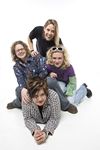
GETTING UNDER (WITH) THE BLUE UMBRELLAS
By Tim Roberts Photos by Laura Roberts
The headings for each section come from the entry "blue" in The Dictionary of Symbols by Jean Chevalier and Alain Gheerbrant, translated by John Buchannan-Brown (Penguin Books, 1994).
"Indifferent and unafraid, centered solely upon itself, blue is not of this world: it evokes the idea of eternity, calm, lofty, superhuman, inhuman even."
The restaurant has about as many television sets as an electronics store: three over the bar, one in each corner of the opposite wall, two on the shelf over the stage at the rear, one in each corner of the dining room in the next part of the building, each showing ESPN or one of its spawn channels where men in suits talk football or golf game highlights are replayed while updated team scores appear in a rectangle below the action. Every seat at the bar is occupied. In the middle of the floor, more than a dozen people have jammed a row of tables together and, since their arrival, have covered them with empty beer bottles and full ashtrays. A pair of waitresses skillfully weave in and among all the tables and patrons, carrying empties and bringing back full ones, then they return to their posts at the end of the bar, eyes scanning for the next wave of a hand or the final toss back of a head as the last swallow of beer is sent down a throat.
On the small stage, scrunched nearly elbow to elbow, are four women wearing Santa hats. The lead guitarist, standing stage right, a lock of her short dark hair curving down from the fuzzy white brim of her hat, DEPT. OF CORRECTIONS stenciled in black on her vibrant orange guitar strap, is singing a cover of Jill Sobule's "I Kissed a Girl," a bouncy song about two women friends sitting together and talking, who suddenly get affectionate with each other. At the line "And we laughed at the world / They can have their diamonds / And we'll have our pearl," a cheer and whoop erupted from the center row of tables. In an odd irony, the widescreen TV over the bar was showing 3, the made-for-ESPN story of the late Dale Earnhardt. Its audio was silent but closed-captioning displayed text of the dialogue. Lots of talk about machines and money and speed and competition: the language of testosterone.
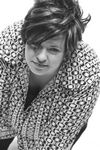
But the song finished with a segue into something different. The tempo increased, guitars were strummed faster. The blonde rhythm guitarist in the center, animated and energetic throughout the performance, making tiny hops and rapid shoulder shrugs, steps closer to the microphone and sings in a full voice with a taste of a drawl, "Daddy was a hard working man / Knows his values and where to stand / And he's proud."
Earnhardt's story on one screen, sportscasts on the others, a tribute in song for a woman's father coming from four women on the stage where minutes ago they were singing about girls kissing each other. Fun reigned and moved too fast for the irony to get a chance to spread infection. And the crowd loved it all.
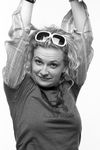
"That's probably what's kept us going this long," said lead guitarist Gloria Marshall, "the fact that we can have so much fun together."
Bassist Stephanie Wolz nodded. "We turn into five year olds."
"I never have grown up," said rhythm guitarist and vocalist Kelly Shouse. "At least that what my mom says."
And drummer Rhonda Baker remained silent with a shy smile on her face, either unwilling to admit her own childlike joy at being part of the band or, unlike the other three, not saying anything about her own maturity that would eventually be set it print.
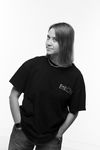
They are the four women of The Blue Umbrellas, sharing their distinctive and energetic amalgam of rock, country, folk and pop with audiences here in their home base of Louisville and at nightspots throughout the region. Their 2004 debut release, metamorphose, on their own GyrlJam Records is a generous (that is, nearly an hour long), cohesive summary of their current work. Even with metamorphose as a permanent record of their sound and the number of people who have heard them play, the music they make can sometimes defy an easy description, especially for the band itself.
"The crazy thing," said Shouse, "is that we ask the people who see us all the time and they don't know how to classify us, either."
"Something infused with something else," added Wolz. "A chemistry experiment. If you took a bunch of people and they mated, we'd be the babies."
Shouse continued. "I always describe it as melodic rock. It's not too hard, it's not too soft. It's right there in the middle. We just combine a lot of different sounds."
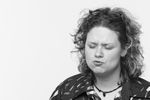
"It's metrorock," Marshall said.
In these days of metrosexuality, with the hybrids of gay and straight cultures linking together like teeth on a zipper, Marshall's single-word summary of The Blue Umbrellas' music fits and metamorphose is its sampler. In it you'll find songs that have Loretta Lynn's unabashed pride in family and hard work, Ani DiFranco's panthergrowl sensuality, Melissa Etheridge's aching-heart passion, Sarah MacLaughlin's ethereal subtlety.
According to Shouse, that was the plan all along, even as the band rehearsed their material and worked club gigs long before metamorphose was released.
"When I started writing," she said, "my key focus was that none of my music was gonna sound the same. It was gonna be different."
"Light blue is the colour of meditation and, as it darkens naturally, it becomes the colour of dreams."
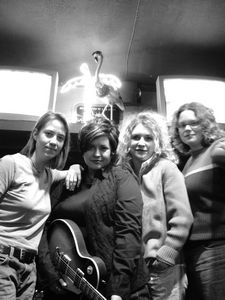
"The cool thing about this band," Shouse said, "that's a little bit different is that we all grew together. It wasn't just a bunch of professional musicians who weren't friends that came together. We were friends before we actually picked up the music."
We were in the dining room of Big Dave's Outpost on Bardstown Road in the Highlands. Formerly Judge Roy Bean's, where it served porterhouse steaks and about as many varieties of wine as an al fresco restaurant in Tuscany, it had been transformed into a neighborhood bar with sports on the dozen television sets mounted on just about every wall, beer flowing from taps or served in chilled bottles and fried pub grub from the kitchen. The Blue Umbrellas were on the bill that night performing, in their words, a special all-acoustic show. Their audience awaited them in the next room: the dozen or so who had pushed a bunch of tables together, along with the crowd at the bar watching the Dale Earnhardt movie. But the dining room where we sate was nearly empty and the mid-December chill from outside seeped in through the large windows.
"I think in coming together and learning together," Wolz said, "you have a chance to grow through your music. If we had all been musicians beforehand and we were all really good when we came together, we'd kind of butt heads here and there with the style, with `don't-play-that-I-want-you-to-play-this.' Instead of that, we would make our own style, we would teach each other things. It's just easier to do that when everyone comes in fresh."
That freshness had its origins in 2000 when The Blue Umbrellas formed from college and other types of connections. Marshall and Shouse met each other at the University of Kentucky, where Marshall was in a band called Southern Comfort with two of her Kappa Kappa Gamma sorority sisters. Shouse met Wolz at a bar in Louisville, then met drummer Rhonda Baker at a party, where Shouse made her play on a drum set that happened to be handy for a drunken dare. Most people play quarter bounce, drain beer bongs, or start weeping when inebriation reaches a certain point at a party. Shouse made Baker pound a drum set along to AC/DC's "Back in Black."
Shouse also made Wolz, who taught herself how to play guitar, learn how to play bass as well. Meanwhile, Marshall had, in her words, an electric guitar sitting around collecting dust, so she taught herself how to play lead. A few rehearsals later, the band made their leap to playing before an audience at an open-mic session hosted by Louisville's Kathleen Hoye.
"We went one night to try to play," Wolz said. "It was bad because we got," she paused, "drunk before we had to play."
"There were some not-so-pretty moments with Kathleen Hoye," Shouse said with a giggle.
Even while fumbling with new instruments and musical roles while attempting to form a band, more mountains remained to be scaled. Most notably, a place to rehearse. They practiced in rooms in Wolz's, Baker's and Marshall's homes. Neighbors called the police, even when they attempted to soundproof whatever room they used. One time a neighbor called the police during a rehearsal, claiming she heard a woman in distress. The last place they tried was the kitchen of Shouse's corner-lot home in the city's Germantown neighborhood.
Shouse said, "Thank God both of my neighbors are very old and deaf. I went over to one of them and said, `We practice every Wednesday night, so if you ever hear us, please let me know before you call the cops.' She said, `Kelly, you know what I'll do if I ever hear you? I'll come over and listen.'"
If finding a regular rehearsal space is only one challenge facing a new band, finding the right name that suits the band and its sound can be just as frustrating. The only difference is that the police won't get called if someone is aggravated by it. But just like the band had luck finding a place to practice next to some elderly folks who are hard of hearing, they had the same kind of serendipity in getting a name.
"We were at Gloria's parents' house for a Derby party," Shouse reported, "and deciced to think of a name for the band. After a few mint juleps and some raunchy names, I leaned my head back in frustration, or maybe inebriation and looked up."
They had been sitting at a table underneath a large blue umbrella. Shouse made the suggestion. It stuck.
Neighborly goodwill, the desire to escape from being a kitchen band (not a garage band because the police would get called if they ever attempted to rehearse in one) to becoming a professional unit, a stockpile of songs, a name: The Blue Umbrellas had most of the pieces ready to make their dream real. But a major piece was missing: direction.
They got it one night after a performance.
"It is the road of infinity on which the real is changed to the imaginary. It is, after all, the colour of the bird of happiness, that blue bird which is always so near yet so far."
Former Groovebilly and Lolligagger (Tim Krekel's and Bryan Hurst's former backup bands, respectively) Peter Rhee, a virtuoso on violin and mandolin, approached The Blue Umbrellas the same way a sculptor approaches any raw medium, whether it is granite or a pile of bronze plates: the final result is inside, the work is in cutting away all the excess.
"Peter's done wonders for this band," Shouse said. "He came to a show when we were pretty rough and he wanted to record us."
"I think he's focused our musicianship quite a bit," Marshall said, "as far as helping us see details we didn't really see before, fine tuning our tempo and melody and he's helped us with song structure to make it more dramatic and impactful."
Rhee's influence and work with The Blue Umbrellas garnered them some time at Jeff Carpenter's Al Fresco's Place studio in the basement of his home in the Belknap subdivision behind Bellarmine College. The roster of Louisville and other musicians who have recorded there includes Heidi Howe, Tim Krekel, Bryan Hurst, Serpent Wisdom and the Lexington rockabilly band Crown Electric. Each had come from Carpenter's studio with a recording loaded with a natural warmth that suited the type of music they played, whether it was a modern take on twang-heavy country, old-style rock-and-roll, or exotic world-beat sounds.
The Blue Umbrellas were no exception. The result of Rhee's guidance and Carpenter's engineering was metamorphose, nearly an hour's worth of material from a band who, four years earlier, were fumbling around with new instruments, screwing up open mic performances and having the police called on them every time they tried to rehearse. Musically the songs range from flat-out country to light pop and slow-burn blues. Lyrically and they cover augured-in relationships ("Love Inside"), love of a parent ("Daddy's Song"), rude people ("Shoo Bitch," which, at first hearing, is not about Imelda Marcos), alcohol intake ("We Women Can Drink") and general horniness ("In My Car," in both slow and fast versions).
It was a triumph for both the band and its mentor/producer, who also became their driver when they took the material from metamorphose on a tour of the northeast that included Boston, Buffalo and Manchester, New Hampshire. The trip also included a backstage meeting with empowerment guru Susan Powder at a show called "Rockin' in the Streets" in Columbus, Ohio.
"We did 40 hours in a long weekend," Marshall said. "We were crammed in a van and Peter drove the whole way."
While the sojourn to the northeast is probably the furthest The Blue Umbrellas have traveled, they still manage to perform in other cities not too far from Louisville, including Nashville, Covington, Lexington and Owensboro, where the band witnessed a fight in a biker bar called The Plantation.
"We were finished playing," Wolz said, "and there were biker people still there and some frat dudes. Some scuffle happened, they took it outside and ended it. Then some biker girl and another girl started fighting. But I think to cap it all off, this biker gang in leather vests all left in trucks and cars."
"I've never seen so many camera phones go off than that night," Shouse added.
"My impression was that we didn't know if they liked us or hated us," Marshall said.
"A lot of people don't see all-female bands," Shouse said. "So when they do, they're just like whoa!
After half a century of rock-and-roll history, female rock bands are still an oddity, despite the success of The Go-Gos, The Bangles, The Donnas, even the 5-6-7-8s from Japan. There never seems to be an incongruity with female vocal groups or rock bands fronted by women. But why do audiences still gape when four women toting guitars and drumsticks take the stage?
"If you look at it, how many times do you see females rockin' out," Shouse asked. "You'll see a female rhythm guitarist singing, but you don't find a female drummer very often, you don't find a female lead guitarist very often and you don't really find a female bassist. So to put all that together, people are just amazed by it."
"There's still a novelty aspect to it," said Wolz.
"Light blue is the colour of meditation and, as it darkens naturally, it becomes the colour of dreams."
Like their musical predecessors, The Blue Umbrellas are also using the girl-band novelty as a basis for empowering other young women, instilling a spirit of fun, providing an opportunity for other women musicians to be heard and seen and feeding the dreams of others who have wanted to pursue music.
"There have been a few women who've come to see our shows," Wolz said, "who've come back the next time and said they'd bought a guitar or went out and bought a bass and learned how to play it. And when we play anywhere there's a family atmosphere where little kids're watching, little girls will stand there and stare at us. We think they'll maybe want to grow up and want to play an instrument."
"An ongoing goal of ours as a band," Marshall added, "is GyrlJam, to strive for an all-female, rockin' out venue. And GyrlJam is also the name of the record label we want to start. We can't help but try to encourage other females to get out and jam."
"Something I'd like to do," Wolz said, "whenever we can arrange it, is to call in people that we've played with, like all female artists or bands fronted by females and just have a festival. It could be an extension of the GyrlJams we've already had. People would come and see that there are a lot of women who play in bands and that every single one of them is good in their own way."
Then there are the other ways the band can make connections with others, sometimes a little more directly.
"You touch so many people in so many different directions," Shouse said. "My greatest moment to this day was when we were playing at the Longshot Tavern. We played ["Daddy's Song"]. It's a very happy song and at the end of the night this girl came up to me and she said, `Kelly, that song meant the world to me.' I asked why and she said, `I lost my father two months ago. That song just moved me. I will be here at every show.' To take a happy song that I wrote about my dad and for somebody to take it totally differently and apply it to their own life is just amazing."
Symbolically, an umbrella has a dual representation. In one, it is viewed as an inverted grail that, after it collects blessings, turns itself over and douses the holder with what it collected. In another, it is shield under which the holder cowers and huddles for safety. With songs that connect with the experiences of others, the dream of a Gyrlapalooza, a producer and mentor at hand to keep them professionally and musically sharp and a parallel growth as musicians and friends, The Blue Umbrellas are not, by any means, huddling under anything for protection.
Instead, they're collecting the blessings and dousing their fans with them.
Find out more at www.theblueumbrellas.com.
